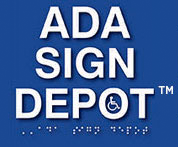Tax-Free Savings Accounts for Disabled
ADA Sign Depot
September 01, 2015

Tax-Free Savings Accounts for Disabled
FROM THE NEW YORK TIMES
SPECIAL savings accounts for people with disabilities are likely to become available in most states next year.
The accounts were made possible in 2014 by the ABLE Act — for Achieving a Better Life Experience — and are loosely modeled on the popular 529 college saving accounts.
Advocates for the disabled say it is taking time to complete the details of the accounts, known as 529A or Able accounts, and to establish the various state programs to manage them.
Heather Sachs, vice president for advocacy and public policy at the National Down Syndrome Society, said the accounts were much anticipated by disabled people and their families: “I get daily emails saying, ‘How can I open an Able account?’ ” she said, adding, “There is a lot of work that needs to be done.”
The timing of the accounts’ availability will probably vary. Virginia, for instance, said it expected to make the accounts available in the first three months of 2016, while Florida has indicated it will offer them by July 1.
The dates differ because the accounts will be administered by the states, and each must approve its own legislation to set up a plan. As of Aug. 13, 40 states and the District of Columbia either had passed laws or had proposals pending, but 10 states had no bill pending, according to an online registry maintained by the Arc, an advocacy group for people with intellectual and developmental disabilities.
The Treasury, meanwhile, has proposed rules to govern the accounts, and will hold a public hearing on them in October.
As with 529 college savings plans, 529A accounts allow contributed funds to grow tax-free, and to be withdrawn tax-free for eligible expenses. Anyone — including family and friends of a disabled person, as well as the disabled person — can contribute to the accounts, but there is no federal tax deduction for the contribution.
An important feature of the accounts is that they allow people with special needs to save for their care and education without disqualifying them from receiving government benefits.
To qualify for help like Medicaid or federal Supplemental Security Income, which assists low-income people who are disabled, a disabled person generally cannot have more than $2,000 in savings or other assets. This discourages many people with disabilities from working, and also makes it hard for families to save for their children’s longer-term needs.
Typically, families must set up a special-needs trust to set aside funds for a disabled child without putting benefits at risk — a step that can involve costly legal fees to establish and maintain the trust. Funds in the Able accounts, however, won’t count toward that limit, so they may provide a simpler, lower-cost alternative for many families.
The accounts, however, have some limitations. To qualify, you must have been disabled before age 26. The funds have an annual contribution limit equal to the annual gift tax exclusion — currently $14,000. The account can grow to $100,000 without jeopardizing federal benefits (although some states may set much higher overall total contribution limits), but balances over that amount may prompt a suspension.
Also, after the beneficiary of a 529A account dies, remaining funds may be required to repay Medicaid benefits.
Because of those provisions, some families may want use a combination of a 529A and a special-needs trust, depending on their financial situation, said Christopher Krell, a financial adviser and principal with Cassaday & Company. With special-needs trusts, there is no contribution limit and they can be structured to avoid Medicaid repayment. “The 529A accounts are great,” Mr. Krell said, “but they’re not going to get rid of special needs trusts.”
Here are some questions about 529A accounts:
■ What sort of expenses can money in the accounts be used for?
As proposed, 529A funds can be used for a broad variety of short-term and long-term needs, including education, health care, housing and transportation, as well as legal and financial expenses.
■ Can an individual have more than one 529A account?
No. Unlike 529 college savings accounts, you can have just one 529A account, and it must be established in the state where you live (or through the program your state contracts with).
■ How can I find out when 529A accounts will be offered in my state?
You can check with the agency that administers your state’s 529 college savings plan for updates. In early September, look for an online 529A resource center at www.ablenrc.org.
- Tags: ADA People Subscribe to this blog's RSS feed.


